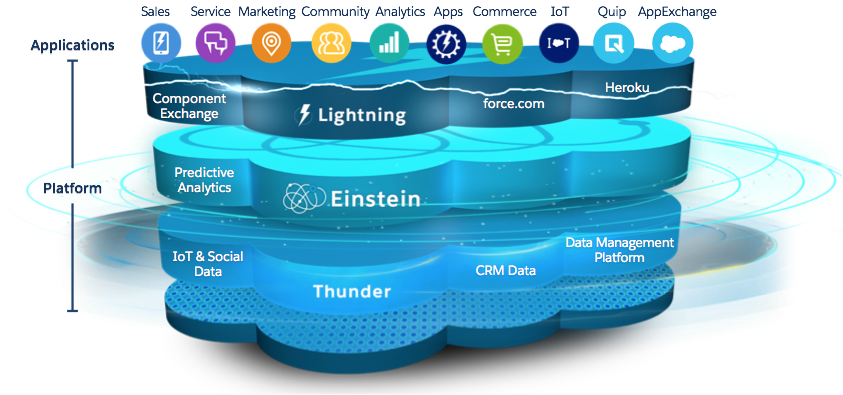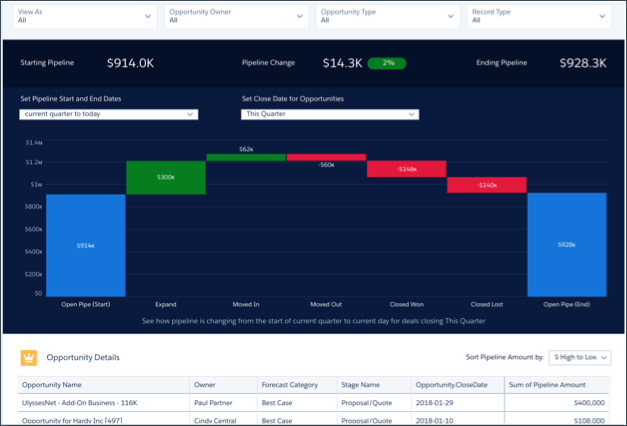Salesforce Ecosystem

Einstein Analytics - complete analytics platform built on top of world's #1 CRM

Einstein Analytics - Sales Analytics
- Turn data into smarter sales with Sales Analytics

Einstein Analytics - Service Analytics
- Creates smarter managers, more productive agents, and happier customers

Einstein Analytics - B2B Marketing Analytics
- Give your entire team an easy view of complex marketing insights

Executive Summary
-
Organizations have an unprecedented opportunity to learn more about their:
- Businesses
- Markets
- Customers
Need to:- Explore
- Analyze
- Gain Insights
Executive summary - contd.
- Non-relational approach to combine heterogeneous data-forms and types
- Search-based query engine
- Simple to use and engaging UI
- Mobile-friendly exprience
- Allows explore data in a fast, agile, self-service way without:
- dependency on data scientists
- cumbersome data-warehouse schemas
- slow and resource-intentsive IT infrastructure
Need for new era of BI
- The data revolution has created tremendous demands on business intelligence. In 2013, it was estimated that 90% of the world’s data had been created in the past 12 months

Need for new era of BI - contd.
- 50,000 GB of data being created every single second
- 70% of all of that data is from customers
- All of this information is being captured in lots of different systems, like CRM, ERP, Supply Chain, HR systems, and even Partner Management systems

User challenges in Traditional BI

- Reduced agility
- Users ask a question and then wait weeks or months for an answer; if they discover the original question was the wrong one, the schema build-out must start all over again. Legacy BI additionally pre-aggregates the data, which limits insights
- A typical BI deployment strikes a balance between anticipated queries and performance
- Example: data is typically rolled up to a higher grain to provide acceptable query performance
- Prevents users from answering second-order or third-order questions
- Users need to go back to IT or use different tooling to answer their questions
Business challenges in Traditional BI

- Not matching with the speed of business:
- Building out a BI schema can take weeks
- Waiting in queue for getting BI/IT resources available
- Lost: Business's failure to act rapidly
- Resource intensive:
- Requires team of experts : IT architects, business analysts, data scientists and project managers
- Not able to exploit data-as-an-asset:
- Current BI warehouses - prohibitive for widespread adoption and usage across the enterprise
- End users cannot nimbly engage in data-driven decision-making
Welcome to Self-service data discovery to users: efficient and valuable!

Why Einstein Analytics?

Einstein Analytics - Powered by AI

Innovations to fix Traditional BI issues

- Salesforce Einstein Analytics:
- Non-relational store
- Search-based query engine
- Advanced compression algorithms
- Columnar in-memory computing
- High-speed visualization engine
- Embraces complexity of heterogeneous data and fluidity of questions
- Provides end user's proclivity for exploring data with agility
9 Technology Principles for Einstein Analytics Platform
- Agility
- Accomodates any data-structure, type or source
- Making them available immediately without a lengthy ETL process
- Search-based exploration
- Data is searched using an inverted index — similar to the Google search engine — allowing for query results within seconds
- Columnar, in-memory aggregation
- Quantitative data is spun up and queried in a columnar store in RAM across Salesforce’s cloud instead of in the row structure of a relational database on disk.
- Speed
- Heavy compression, optimization algorithms, parallel processing and other strategies allow sub-second and highly efficient queries on extremely large datasets.
- Actionability - Actionable Insights
- Once a user has discovered an insight or made an important decision, they can instantly take the next best action right from within the EA
- Interactivity
- Fast, intuitive, visualization promotes user adoption and contextual understanding — bringing true self-service analytics to every business user
- Mobile-first design
- Open, scalable cloud platform
- Easy-to-use APIs, EA's architecture enables deep relationships with third-party tools and complements existing BI solutions.
- Deeply integrated with Salesforce so you can see your Sales Cloud and Service Cloud data like never before, collaborate, and take action from within Salesforce.
- Security
- Inherits Salesforce’s proven, multilayered approach to data availability, privacy and security, with the additional benefit that data on the Salesforce platform need not move outside of Salesforce servers to be available for analytics
EA High Level Architecture

1. Agility: Ingest, index, and begin analyzing data immediately
Traditional: Wallfall approach:
- Gather requirements
- Figure out relationships
- Pre-determine the data structure
- Add a semantic layer to the data
- Ingest the data
EA way - ELT - Extract Load Transform:
- Data is extracted, Loaded, Indexed
- Made available immediately for analysis or additional transformations
- Enables immediate search and exploration of the raw data, allowing the analytics tool to detect patterns and relationships instead of requiring a lengthy data normalization process
- Data is loaded into non-relational store, with a dynamic, horizontally scalable key-value pair approach
- The workflow engine applies small, inline transformations upon ingestion — pruning, filtering, partitioning, and augmenting — but largely stores the data in its native form.
- User can gain rapid access to the data, and can immediately determine in what ways the data is relevant to user's needs — without weeks or months of investment in cleaning up data before exploring it
- Makes self-service data exploration rapid and iterative, putting the ability to understand relationships between data in the hands of the end users and allowing enterprises to dramatically shorten the path to innovation
2. Search-based exploration

- Process queries of large, heterogeneous datasets in seconds
- Data is ingested and stored as key-value pairs in a non-relational inverted index, permitting variable numbers of dimensions and attributes for data and the accommodation of text strings and unstructured data, as well as data sets with variable levels of completeness or characterization
-
Highly optimized, using techniques:
- differential encoding
- vector encoding
- incremental encoding
- to compress data and make queries on compressed data as fast and efficiently as possible
3. Columnar, in-memory aggregation and calculation

- Gain incredible speed by dramatically optimizing the query
- Queries quantitative data in an in-memory columnar store, rather than against rows and tables on disk, optimizing the size of the dataset and the query process itself, as the engine does not need to process rows of data and can avoid reading columns not related to a query
4. Speed : Get instant answers from free-form navigation and exploration

- Performance of a query depends on a combination of data structure and query strategy, and EA brings both together
- With the inverted index, EA permits datasets equivalent to up to a billion rows to be queried in seconds
-
Using a variety of compression techniques, the workflow engine that ingests
and transforms data is able to store it at a significantly
smaller size than the original source data — at compression
ratios > 90%.
The specialized compression and the algorithms that operate on a compressed data platform perform significantly better on modern CPUs, resulting in more efficient computation -
The query engine relies on the massively
parallel processing architecture of Salesforce’s cloud – with
more than 40,000 available processors in the cloud, further
powering computations at near-instantaneous speed
However, because of the heavy compression, EA uses as few resources as possible to reach answers to queries
5. Actionability: take the next logical step right within
-
EA's built-in tools called EA Actions that allow user to quickly go from question
to answer to action without logging into a separate solution.
Now when the user finds an answer, the user can immediately create a task, update a record, log a call, and more — and all without waiting for legacy technology or data analysts.

6. Interactivity: encourage adoption and exploration with a powerful visualization layer

- Visualize data and customize views in ways that are intuitive and interactive and that encourage faceting and exploration
- Designed with gamification principles in mind, using simple, beautiful graphics that immediately engage users and fire up their curiosity to play and discover
- Uses SVG graphics within the browser, and uses an animation engine when the graphics shift as users filter and change views, resulting in fast-rendering graphics that connect the relationships between views of data – and demand few resources from the user’s device or the server
- Users can easily combine datasets and create custom dashboards to explore questions from different angles and using different combinations of information.
7. Mobile-first: put information in users’ hands, literally
- Mobile users can visualize and interact with data, run queries, and develop dashboards as rapidly and intuitively as they can on a Desktop, with equally rapid response times
- Salesforce does not leave data locally on mobile devices or laptops, so enterprises do not need to be concerned about data theft when a device or laptop is stolen or lost

8. Open, scalable cloud platform

- Gain value faster and get more from BI investments
- Allows flexibility and agility by interfacing easily with third-party tools
- Enterprises can complement and supplement existing BI solutions and build new ones as custom needs arise, so they can derive more value from their existing BI and IT investments
- A complete, rich set of APIs invites third parties and enterprises to build their own analytics tools and applications on top of EA
- Integral part of Salesforce’s Customer Success Platform
- The ability for enterprises to scale up and down in their data analytics usage without investing in hardware and on-site IT resources — as well as high performance and speed
- Native integration with Salesforce Sales Cloud, Service Cloud, App Cloud, and Community Cloud enables enterprises to rapidly achieve time to value by layering on additional data to begin understanding customers, sales performance, and markets on a deeper level with data from any other source
9.Security: trust is inherent with Salesforce’s secure cloud

- Salesforce’s world-class privacy program and security infrastructure extends to the EA Platform
- Multi-layered approach to protecting, monitoring, and staying ahead of security challenges
- Salesforce security and privacy measures include a robust information security governance model, security coding and testing through each layer of development, investment in network defense, and comprehensive physical and operational security at all Salesforce facilities.